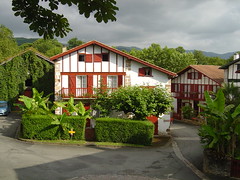Some information about the traditions in Euskal Herria via EITb:
Last Monday of Gernika
There is a market in the Basque town of Gernika-Lumo every Monday in the year but last Monday of October this town hosts the most important fair in Bizkaia.
The big fair in the historical capital of Bizkaia has a ‘proper’ name: ‘Last Monday of Gernika’. The celebration of the Basque Championship of fruits, vegetables, flowers, cheeses, txakoli (Basque white wine) and honey is one of the most important fairs in the whole Basque Country, with more than 100,000 visitors. People usually crowd the centre streets of this village around the 900 stands.
The activity begins early in the morning. The producers come at 8:00 hours. Between 9:00 and 10:30, the jury classifies the products so that the exhibitors can start selling their products. Pasacalles (parades through the streets) and bertsolaris (improvisers of verses in Basque) enliven the day.
After the awards ceremony in front of the Mercurio Fountain (13:30 hours), the exhibitors clear their stands at 14:00. The festive atmosphere goes on in the afternoon with the celebration of Basque pelota matches.
Few traditional surviving market
The Gernika-Lumo Monday Market is one of the few surviving traditional markets in the Basque Country, used by professional agricultural producers and sales intermediaries. The latter are a peculiarity of rural Euskadi, and they operate as distributors of Basque produce, visiting all the farmhouses and buying produce from those who would otherwise not actually go to the town market, and this perpetuates the tradition of the small non-professional producer.
The market place is Plaza de Gernika, Calle Don Tello, near the bus and train station. The building has a trading area of 4,960m2, divided into a covered open area and a closed area. The covered area accounts for most of the market area, and every Monday there are 280 stalls selling local produce, fresh greens and vegetables, fruit, flowers and plants, Basque cake and bread, sheep’s cheese, goat’s cheese and cow cheese, chickens and rabbits.
.... ... .

